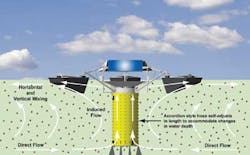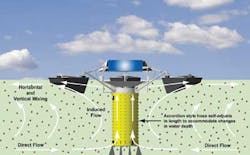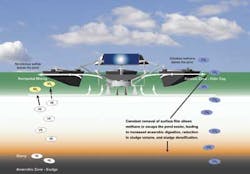By Joel Bleth
Operators have several options for dealing with odor control problems associated with wastewater treatment ponds, from increasing the aeration to applying chemicals to the water or perfume to the air. But often these solutions are expensive and not totally effective. Another alternative—long-distance circulators or mixers—has emerged as a method for controlling odors in many wastewater ponds.
These mixers are installed on the pond's surface and consist of a solar-powered or grid-powered motor, an axial flow impeller that pulls water up from the intake to the surface where is it spread out at 360 degrees, an adjustable-depth intake hose, and a power control system.
Long distance circulators are different from any other reservoir equipment in that the adjustable intake takes advantage of the manner in which water forms thin horizontal layers in ponds, and allows a precise horizontal cross-section of water to be circulated throughout the entire pond footprint. This circulated zone can be indexed to the top of the pond, such as a setting to circulate just the top X feet of the pond, or the intake hose can be set to circulate the entire depth of the pond regardless of how full the pond is.
This article discusses how this unique characteristic allows long distance mixers to control odors in two types of wastewater treatment ponds, equalization ponds and anaerobic ponds.
Equalization Ponds
An equalization pond in front of a wastewater treatment plant acts as a shock absorber by temporarily holding excess inflow during rain events until the water can go through the treatment plant.
For example, an equalization basin may be designed to hold eight million gallons of water when full at eight feet deep, but normally be operated with two million gallons in the pond at a depth of three to four feet, with one million gallons per day entering the pond and going through to the treatment plant. During a heavy rain, the equalization pond may quickly fill to the depth of eight feet and then, a few days later, be back down to three feet.
In this type of pond, without thorough mixing, the organic solids entering the pond will tend to settle to the bottom and, over time, the anaerobic digestive process at the bottom can create ongoing odor problems. But by keeping the solids and water thoroughly mixed, the solids move on to the plant instead of settling to the bottom, and the detention time of both the water and the solids is too short for the anaerobic process to create an odor problem.
In these ponds, the unique design of a long distance circulator, set with the intake hose all the way to the bottom of the pond, will automatically allow full mixing of the pond as it goes through depth changes, without any adjustment being needed and without damaging the bottom of the pond in any way.
Anaerobic Ponds
Some wastewater treatment ponds, such as waste sludge storage ponds in activated sludge systems, are purposely designed for anaerobic digestion and thus produce sulfides and odors continuously throughout most of the pond depth. To eliminate odors emanating from these ponds, operators can maintain an oxygenated layer of water at the surface of the pond, sometimes called an "odor cap." When sulfide gas bubbles rise toward the surface of the pond, they are instantly oxidized to non-odorous sulfate as they pass through the oxygenated odor cap.
A thin odor cap at the top of the pond, even 1 inch thick, is all that is required to neutralize sulfide odors. But a thin odor cap can be disturbed by wind, which would then let odors escape, so usually it is best to have a one- to three-foot thick odor cap.
Floating circulators are ideal for creating an odor cap on top of the pond, because their intake hoses can be set for a shallow water depth, usually 1-3 feet, and because one machine will circulate to the edge of the pond in all directions. Consequently only one machine is usually needed per pond. Circulators maintain the oxygen in the odor cap through two mechanisms, (a) capture of photosynthetic oxygen during the daylight hours, and (b) surface re-aeration during the nighttime hours. Since the machine is not bringing up any BOD loading from deeper water, because there is no turbulence, usually there is no problem in maintaining oxygen in the odor cap 24 hours per day.
Regardless of what type of equipment is used to create and maintain an odor cap on an anaerobic pond, three practices are crucial to proper odor control in an anaerobic pond:
- 1. Inflow to the pond should be kept below the odor cap, so that the influent BOD does not use up the oxygen in the odor cap. If the odor control plan calls for a three-feet-thick odor cap at the top of the pond, the inflow should be brought in horizontally at four feet deep or deeper. If an old pond is converted to sludge storage and the horizontal inflow pipe is not deep enough, than add a baffle or 45-degree elbow with a short pipe extension so that the inflow water does come in below the odor cap. And in ponds where the influent water enters vertically at the bottom of the pond, place a deflector, similar in shape to a card table, over the influent pipe to deflect incoming water into a horizontal pattern instead of allowing it to shoot up to the surface of the pond.
- 2. Similarly, the effluent should also be drawn off the pond from below the odor cap. This prevents the oxygenated water that comprises the odor cap from being drained off the pond. If an old pond is being converted to use for sludge storage and it has a skimming outlet pipe, devise an anti-skimming baffle, or 45-degree elbow and short pipe extension, to allow water leaving the pond to come from below the odor cap.
About the Author: Joel Bleth is president of Medora Corp. The company recently announced plans to market its solar- and electric-powered circulation equipment under two brands, SolarBee and GridBee. Medora Corp. will continue to be based in Dickinson, ND.
SolarBee is an exhibitor at the WEFTEC.12 event and can be found at Booth No. 7251





